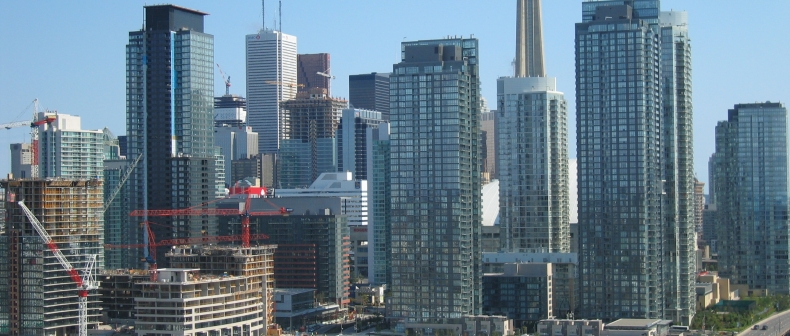
If you walk down the street on any given night during the final week of August or the first week of September, you can see entire front lawns covered in garbage bags and strewn with remnants of broken furniture. It is the detritus of temporary living, reminding you it is Moving Day for thousands of students across the city, whose old stuff must be removed to make way for the new lives that have come to occupy old space.
On September 1st, I was one of those people cleaning out my subletted apartment and purging unwanted belongings that no longer fit into my life. I have ghost apartments all over this province that I inhabited once but no longer, filled with memories of love, pain, and vomit. Each time I moved, I desperately hoped it would be the last — a living arrangement would prove itself not temporary. Yet each place, I seemed to move out of even more hastily than the last, quickly packing up my belongings and unloading them into a new space, arranging them feng shui style in a way I thought could make me happy.
Now that I have lived in four different apartments in the last four years, I never want to move again. Most of all, I just want a place to call my home. Houses are comprised of four walls that you have the keys to get into, somewhere to stash your purse. Homes are warm and friendly, and want nothing more than for you to relax, unwind and come undone.
None of the apartments I lived in I would particularly call a home. The first apartment I moved into was the small main floor of a house — tiny as hell, but we made it our own, with Christmas lights and Earth Day posters. The second place was larger and infinitely lonelier. It didn’t matter that it had a dishwasher, and more cupboard space than we had dishes — I never spoke to my roommates and it made me want to die. I was only there for 8 months. The third apartment was actually an entire house, shared with four other friends. While the social aspect of living there was somewhat superior to the last, I hated it more in just about every other way. It was cheaper sure, but it was filthy — drawers filled with mouse poop and roommates who left their belongings scattered all over the living room, never washed dishes and left food in the fridge until it was moldy.
Five months ago when I first moved to Toronto, I stayed in a subletted room, with bars on the windows and a mattress on the floor. There was no storage space, no counter space, and no room for me to breathe. It was always dark in there, even at the height of the afternoon and I could feel myself growing more lonely and isolated by the minute.
When I walk around the residential streets in neighbourhoods like Leslieville or Cabbagetown, I am struck by how much the beautiful, old houses look like homes. What make a house a home? Is it the abundance of lush greenery outside the front step? The presence of a purring cat? The big comfy chairs I can see in the living room? Is it the curtains that always seem to be open, inviting you in even when you don’t live there?
From my outsider perspective, the people who live in these homes seem to have families, good jobs, and lots money in the bank. They do not move every single year on September 1st. They have a sense of stability in their living situation, so they must have a sense of stability in their lives. Right?
It isn’t the things inside the house that make it a home per se, but the level of care that people have bestowed onto their homes. Homes are filled with plants that need to be watered, gardens that need to be kept, shelves of books just waiting to be read and maybe even children looking for warmth and affection. It all sounds terribly needy, but it is the houses we put the most effort into fulfilling these needs that become our homes. Homes are filled with things — not necessarily expensive things — but things that are treasured and take a lifetime to collect. You can spread out and simply be yourself, without having to fret over which dishes in the sink are yours.
The quality of your home can have extreme effects on your psychological well-being. An article called “The Built Environment and Mental Health” outlines that there is a positive correlation between housing and neighbourhood quality and mood — the better quality the house, the happier you will be, generally. We feel the effects of crowding (due to people or objects), noise levels, air quality, and the amount of light in our space. If our apartments are dank, musty basements with no natural light, we won’t be able to absorb the Vitamin D we need, which helps regulate our mood and sleep patterns. Symptoms of depression are linked to insufficient daylight. That’s probably why no one lives in Antarctica, where it is engulfed in total darkness for six months out of the year.
Similarly, interior design itself can have an affect on mood. One study titled “Visual Effects of Interior Design in Actual-Size Living Rooms on Physiological Responses” tested people’s physical responses to different rooms and found that the test room with a classic interior design style produced a state of calm and relaxation, whilst the room with visible posts and beams triggered mental activity and arousal. It is also believed that colours can produce different mental results – warm tones are supposed to generate stimulation, while cool tones are associated with relaxation. There is even such thing as colour therapy — the idea that different colours have different healing properties that correspond to different areas of the body – though it remains to be seen whether that is total hokey or not.
So, the surroundings we live in have an undeniable effect on the way we feel, which gives us all the more reason to surround ourselves with beautiful things that make us happy. We spend our whole lives collecting stuff, and our homes are the place where we put that stuff, arranging it into beautiful patterns, making your space a reflection of who you truly are. No house decorated identically to a room in Martha Stewart Living will ever be a home — it would be too manicured, sterile and devoid of personality.
We crave personality in our homes: to let our spaces reflect ourselves by displaying our beloved objects (beauty is in the eye of the beholder, always), as well as our curiousity leads us to want to explore the homes of others. Such curiousity can be linked to the popularity of websites that share photography of other people’s homes.
There is The Selby, a site where we can peek into the homes of people we want to be and gaze upon the small nuances in decoration that make their homes extraordinary, like writing on the bathroom walls, and closets filled with colour. There is The Coveteur, essentially the fashion world’s answer to The Selby, in which the heartbreakingly expensive possessions of prominent fashionistas are arranged in an artful manner. There is also The Image Interview, Toronto’s answer to The Selby where photographer Joel Yum goes into the homes of Toronto natives – like comedian Alice Moran – to capture their living space, in addition to capturing their essence in a studio portrait session.
The homes featured on these websites are breathtakingly beautiful. Many of the subjects of these profiles (especially on The Coveteur) are also breathtakingly rich. The good news is, having a beautiful home doesn’t have to mean having a lot of money – it just means displaying your most prized possessions in a meaningful way, and looking at things that make you happy over and over again. Who even knows if we could live in these places that we envy yet are so deeply reflective of the lives and interests of other people. We need space that is uniquely our own.
Beyond that, humans need to live in spaces that are free of cockroaches and bedbugs, have windows with a view of more than a brick wall and are quiet enough that the street doesn’t keep you up at night. But how do we find our perfect space in this city of overpriced basement apartments? Apartment hunting is almost like the search for the Holy Grail, and is especially difficult to find a place with all of these things where you can actually afford to pay the rent.
Truthfully, most young people have to make a compromise, and lose out on some of the basic traits of a decent living space just to find somewhere they can afford. Keeping this in mind, it almost a positive thing that our living situations are so transient, so hopefully each place we live in will be slightly better than the last. Overall, we just need to find a half-decent place that makes us happy. Perhaps I am not yet at that level of stability required to call my rented apartment a “home,” but I am hopeful that next year on September 1st, I will wake up and not have to worry about hauling my belongings across the city.
____
Isabel Slone is a Toronto-based fashion blogger and writer. Follow her on Twitter at @isabelslone.
For more, follow us on Twitter @TorontoStandard and subscribe to our newsletter.














